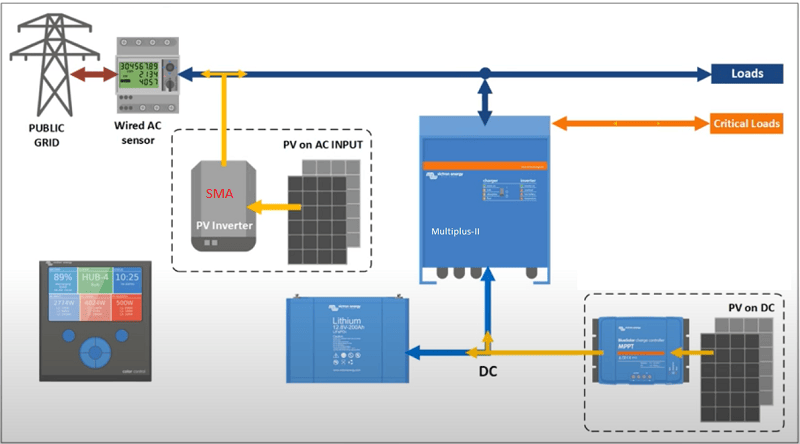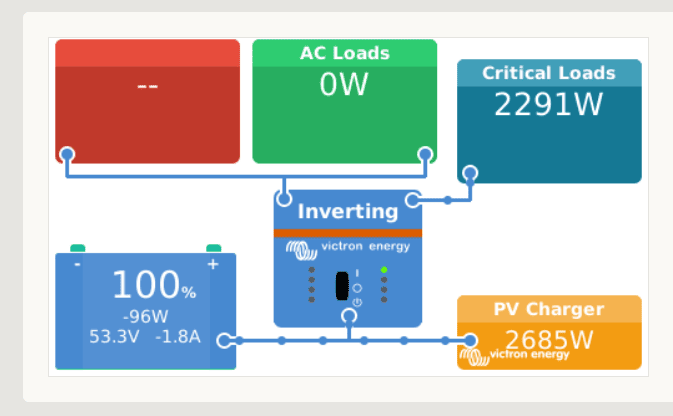A critical load panel is regarded as a secondary electrical panel next to your main electrical panel. It is also called an essential load panel. Both are the same.
When the grid is down, it is used to supply power to your appliances that need it the most. The power is supplied by a battery.
Your main electrical panel will be without power during the outage. Therefore it’s important to only add essential items to your critical load panel. These appliances can be:
- A fridge
- Freezer
- Some lights
- Well pump
It is important that there are no big loads on it like an electric cooker or AC unit. Because those use a lot of power and will drain your battery quickly. If there is a power outage for several days, you want to keep the battery from going empty quickly.
How Does a Critical Load Panel Work?
A critical load panel in normal conditions works just like your main electrical system. The difference here is that all the critical loads are wired in your critical load breaker box.
The critical load panel is supplied by an inverter that comes from a battery. If you already have a solar system, you can charge the battery with the solar panels.
The Multiplus II from Victron works like this:

In the diagram, you can see that the critical loads have a separate AC output. This output will feed the critical load panel.
If the grid is down, the battery can only get charged from the PV on DC (bottom right). The PV on AC input (top left) will be disabled. This is to protect the electricians who work on the lines in the street.
What Happens When The Grid Goes Down?
In normal working conditions, both the main electrical panel and the critical load panel is delivering power to the loads.
In a situation when the grid goes down, the inverter will shut off its main AC output. It will sense that the grid is down and only deliver power to the critical load panel. Use my calculator to calculate your needed battery capacity.

In this diagram, the DC-coupled solar system will still continue to charge the battery. The AC loads are 0W because this output has been shut off. The critical load output keeps working to supply the critical loads in your house.
How Do You Make a Critical Load Panel?
You will have to rewire your existing main electrical panel. That is the hard part.
Make a separate electrical box which will be your main critical load box. You can do this in three methods.
- Rewire your whole house so that the critical loads are completely separated.
- Leave the existing electrical system as it is but wire another electrical panel from the inverter and run extension cords when you need it. A fridge can be plugged in with an extension cord when the power goes out.
- Rewire a few circuits from your house. These can be the sockets in the kitchen, a few light circuits, and the sockets from the bedroom for example.
Option 1 is going to be the cleanest solution, but it will take time and money. It is ideal for new houses where the electricity still has to be arranged.
Option 2 is more manageable but isn’t going to be as clean as option number one. It’s a good choice if you don’t want to spend much time or don’t have many blackouts. Reducing the frequency to run extension cables to your appliances.
Option 3 would be my preferred way of wiring a critical load panel.
Tips for Using a Critical Load Panel
Make sure the power of the critical loads does not exceed the capability of the inverter.
Try to limit as many power-hungry appliances like dryers, AC, cooktops, space heaters, and pool pumps, … These consume a lot of power which will drain your battery fast. If you really need AC, then think about adding a generator to your system.
You can integrate your solar panels in the system. If your solar panels are wired to an inverter that supplies the AC system, then they cannot charge up your batteries during a blackout. This is called an AC-coupled system. When your solar panels are wired to your batteries directly through a charge controller, then the battery will charge with the solar panels. This is called a DC-coupled system.
If you want to install a critical load panel with batteries I recommend placing your batteries at least a few feet from the ground. This is to prevent damage from floods if your area has them.
FAQ
How much does a critical load panel cost?
The answer is: it depends. How big does your battery need to be? The average cost for installing the critical load panels for domestic batteries ranges from $2000 to $3000 for a 10kWh battery. This is without any additional inverters, charge controllers, or solar panels.
What is a critical load in a solar system?
Critical loads are the loads you cannot live without and would cause damage or loss when there is no electricity. These can be the freezer, fridge, well pump,… These can be powered with a solar system, just like an off-grid solar system.
Is a critical loads panel necessary?
A critical load panel is not necessary, but you will be more comfortable in a blackout or grid-down situation. Your essential appliances will keep working as long as your battery supports the load.
What battery should I use?
I recommend using LiFePO4 batteries. Use the server rack type. You can stack these in a tower-like configuration. You can expand your battery whenever you want. Use a 48V system, it will be cheaper than a 12V or 24V system.
 I have written a book that contains all the information you need to get started with off-grid solar power.
I have written a book that contains all the information you need to get started with off-grid solar power.
With over 1,400 reviews at 4.5 stars, I can almost guarantee that this book will save you $100’s on buying the right equipment.
You can buy it here on Amazon.com

I’m an off-grid enthusiast. I created this website to give clear and straight-to-the-point advice about solar power. I’m also the author of the book ‘Off-grid solar power simplified‘. Read more about me on my about page, check out my Youtube channel, or send me a message.